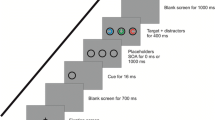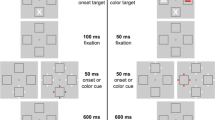Abstract
Prior research suggested that attentional capture by subliminal abrupt onset cues is stimulus driven. In these studies, reacting was faster when a searched-for target appeared at the location of a preceding abrupt onset cue compared to when the same target appeared at a location away from the cue (cueing effect), although the earlier onset of the cue was subliminal, because it appeared as one out of three horizontally aligned placeholders with a lead time that was too short to be noticed by the participants. Because the cueing effects seemed to be independent of top–down search settings for target features, the effect was attributed to stimulus-driven attentional capture. However, prior studies did not investigate if participants experienced the cues as useful temporal warning signals and, therefore, attended to the cues in a top–down way. Here, we tested to which extent search settings based on temporal contingencies between cue and target onset could be responsible for spatial cueing effects. Cueing effects were replicated, and we showed that removing temporal contingencies between cue and target onset did not diminish the cueing effects (Experiments 1 and 2). Neither presenting the cues in the majority of trials after target onset (Experiment 1) nor presenting cue and target unrelated to one another (Experiment 2) led to a significant reduction of the spatial cueing effects. Results thus support the hypothesis that the subliminal cues captured attention in a stimulus-driven way.


Similar content being viewed by others
Notes
Non-specific temporal orienting comes in different forms. On the one hand, cues can lead to volitional temporal preparation so that participants use the cues to strategically expect the target within a specific time window (e.g., Correa, Lupiáñez, Milliken, & Tudela, 2004). Another way non-specific temporal cues can impact on performance is by alerting, which leads to a transient state of preparedness/arousal shortly following the time of the cue onset (Los & Shut, 2008; Weinbach & Henik, 2012). Effects of alerting are considered to be more automatic than volitional temporal orienting, and they strongly depend on temporal contingencies between cue and target onset (Laidlaw & Kingstone, 2017; Weinbach & Henik, 2012).
In contrast to the target, the cue and placeholders are of lower contrast (e.g., Mulckhuyse et al., 2007; Schoeberl et al., 2015) and cover a smaller overall area. As higher overall stimulus energy decreases the latency with which stimuli are perceived (Purushothaman, Patel, Bedell, & Ogmen, 1998), it is thus possible that the participants subjectively perceived the cue and the placeholders to precede the target even in conditions in which placeholders and target had objectively simultaneous onsets. Note how the low visibility of the cue’s head start relative to the placeholders would have benefited the grouping of cue and placeholders and, hence, an energy-based latency advantage, as well as incorporation of the cue into a top-down set to search for all three stimuli, cue and placeholders, as warning signals.
References
Bertelson, P. (1967). The time course of preparation. Quarterly Journal of Experimental Psychology, 19, 272–279. https://doi.org/10.1080/14640746708400102.
Bertelson, P., & Tisseyre, F. (1968). The time-course of preparation with regular and irregular foreperiods. Quarterly Journal of Experimental Psychology, 20, 297–300. https://doi.org/10.1080/14640746680400165.
Burnham, B. (2007). Displaywide visual features associated with a search display’s appearance can mediate attentional capture. Psychonomic Bulletin & Review, 14, 392–422. https://doi.org/10.3758/BF03194082.
Correa, A., Lupiáñez, J., Milliken, B., & Tudela, P. (2004). Endogenous temporal orienting of attention in detection and discrimination tasks. Perception & Psychophysics, 66, 264–278. https://doi.org/10.3758/BF03194878.
Folk, C. L., & Remington, R. W. (2015). Unexpected abrupt onsets can override a top-down set for color. Journal of Experimental Psychology: Human Perception and Performance, 41, 1153–1165. https://doi.org/10.1037/xhp0000084.
Folk, C. L., Remington, R. W., & Johnston, J. C. (1992). Involuntary covert orienting is contingent on attentional control settings. Journal of Experimental Psychology: Human Perception and Performance, 18, 1030–1044. https://doi.org/10.1037/0096-1523.18.4.1030.
Fuchs, I., & Ansorge, U. (2012). Inhibition of return is no hallmark of exogenous capture by unconscious cues. Frontiers in Human Neuroscience, 6:30, 1–8. https://doi.org/10.3389/fnhum.2012.00030.
Fuchs, I., Theeuwes, J., & Ansorge, U. (2013). Exogenous attentional capture by subliminal abrupt-onset cues: Evidence from contrast polarity independent cueing effects. Journal of Experimental Psychology: Human Perception and Performance, 39, 974–988. https://doi.org/10.1037/a0030419.
Gibson, B., & Kelsey, E. (1998). Stimulus-driven attentional capture is contingent on attentional set for displaywide visual features. Journal of Experimental Psychology: Human Perception and Performance, 24, 699–706. https://doi.org/10.1037/0096-1523.24.3.699.
Goller, F., Ditye, T., & Ansorge, U. (2016). The contribution of color to attention capture effects during search for onset targets. Attention, Perception, & Psychophysics, 78, 789–807. https://doi.org/10.3758/s13414-015-1053-8.
Hayward, D., & Ristic, J. (2015). Exposing the cuing task: The case of gaze and arrow cues. Attention, Perception, & Psychophysics, 77, 1088–1104. https://doi.org/10.3758/s13414-015-0877-6.
Klein, R. M. (2000). Inhibition of return. Trends in Cognitive Sciences, 4, 138–147. https://doi.org/10.1016/S1364-6613(00)01452-2.
Laidlaw, K. E. W., & Kingstone, A. (2017). If not when, then where? Ignoring temporal information eliminates reflexive but not volitional spatial orienting. Vision, 1, 12. https://doi.org/10.3390/vision1020012.
Los, S. A., & Shut, M. L. J. (2008). The effective time course of preparation. Cognitive Psychology, 57, 20–55. https://doi.org/10.1016/j.cogpsych.2007.11.001.
Los, S. A., & Van Den Heuvel, E. (2001). Intentional and unintentional contributions to nonspecific preparation during reaction time foreperiods. Journal of Experimental Psychology: Human Perception and Performance, 27, 370–386. https://doi.org/10.1037/0096-3445.134.1.52.
McCormick, P. A. (1997). Orienting attention without awareness. Journal of Experimental Psychology: Human Perception and Performance, 23, 168–180. https://doi.org/10.1037/0096-1523.23.1.168.
Mulckhuyse, M., Talsma, D., & Theeuwes, J. (2007). Grabbing attention without knowing: Automatic capture of attention by subliminal spatial cues. Visual Cognition, 15, 779–788. https://doi.org/10.1080/13506280701307001.
Purushothaman, G., Patel, S. S., Bedell, H. E., & Ogmen, H. (1998). Moving ahead through differential visual latency. Nature, 396, 424. https://doi.org/10.1038/24766.
Schoeberl, T., Fuchs, I., Theeuwes, J., & Ansorge, U. (2015). Stimulus-driven attentional capture by subliminal onset cues. Attention, Perception & Psychophysics, 77, 737–748. https://doi.org/10.3758/s13414-014-0802-4.
Theeuwes, J. (1992). Perceptual selectivity for color and form. Perception & Psychophysics, 51, 599–606. https://doi.org/10.3758/BF03211656.
Theeuwes, J. (2010). Top-down and bottom-up control of visual selection. Acta Psychologica, 135, 77–99. https://doi.org/10.1016/j.actpsy.2010.02.006.
Townsend, J. T., & Ashby, F. G. (1978). Methods of modeling capacity in simple processing systems. In J. Castellan & F. Restle (Eds.), Cognitive theory (Vol. 3, pp. 200–239). Hillsdale, NJ: Erlbaum.
Townsend, J. T., & Ashby, F. G. (1983). Stochastic modeling of elementary psychological processes. Cambridge, MA: Cambridge University Press.
Van der Burg, E., Olivers, C. N., Bronkhorst, H. W., & Theeuwes, J. (2009). Pip and pop: Nonspatial auditory signals improve spatial visual search. Journal of Experimental Psychology: Human Perception and Performance, 34, 1053–1065. https://doi.org/10.1037/0096-1523.34.5.1053.
Weinbach, N., & Henik, A. (2012). Temporal orienting and alerting: The same or different? Frontiers in Psychology, 3, 236. https://doi.org/10.3389/fpsyg.2012.00236.
Weinbach, N., Shofty, I., Gabay, S., & Henik, A. (2015). Endogenous temporal and spatial orienting: Evidence for two distinct attentional mechanisms. Psychonomic Bulletin & Review, 22, 967–973. https://doi.org/10.3758/s13423-014-0750-y.
Yantis, S., & Jonides, J. (1984). Abrupt visual onsets and selective attention: Evidence from visual search. Journal of Experimental Psychology: Human Perception and Performance, 10, 601–620. https://doi.org/10.1037//0096-1523.10.5.601.
Author information
Authors and Affiliations
Corresponding author
Ethics declarations
Conflict of interest
All authors declare that they have no conflict of interest.
Ethical approval
All procedures performed in studies involving human participants were in accordance with the ethical standards of the institutional and national research committee and with the 1964 Helsinki declaration and its later amendments or comparable ethical standards. This article does not contain any studies with animals performed by any of the authors.
Informed consent
Informed consent was obtained from all individual participants included in the study.
Rights and permissions
About this article
Cite this article
Schoeberl, T., Ansorge, U. The impact of temporal contingencies between cue and target onset on spatial attentional capture by subliminal onset cues. Psychological Research 83, 1416–1425 (2019). https://doi.org/10.1007/s00426-018-1001-z
Received:
Accepted:
Published:
Issue Date:
DOI: https://doi.org/10.1007/s00426-018-1001-z




